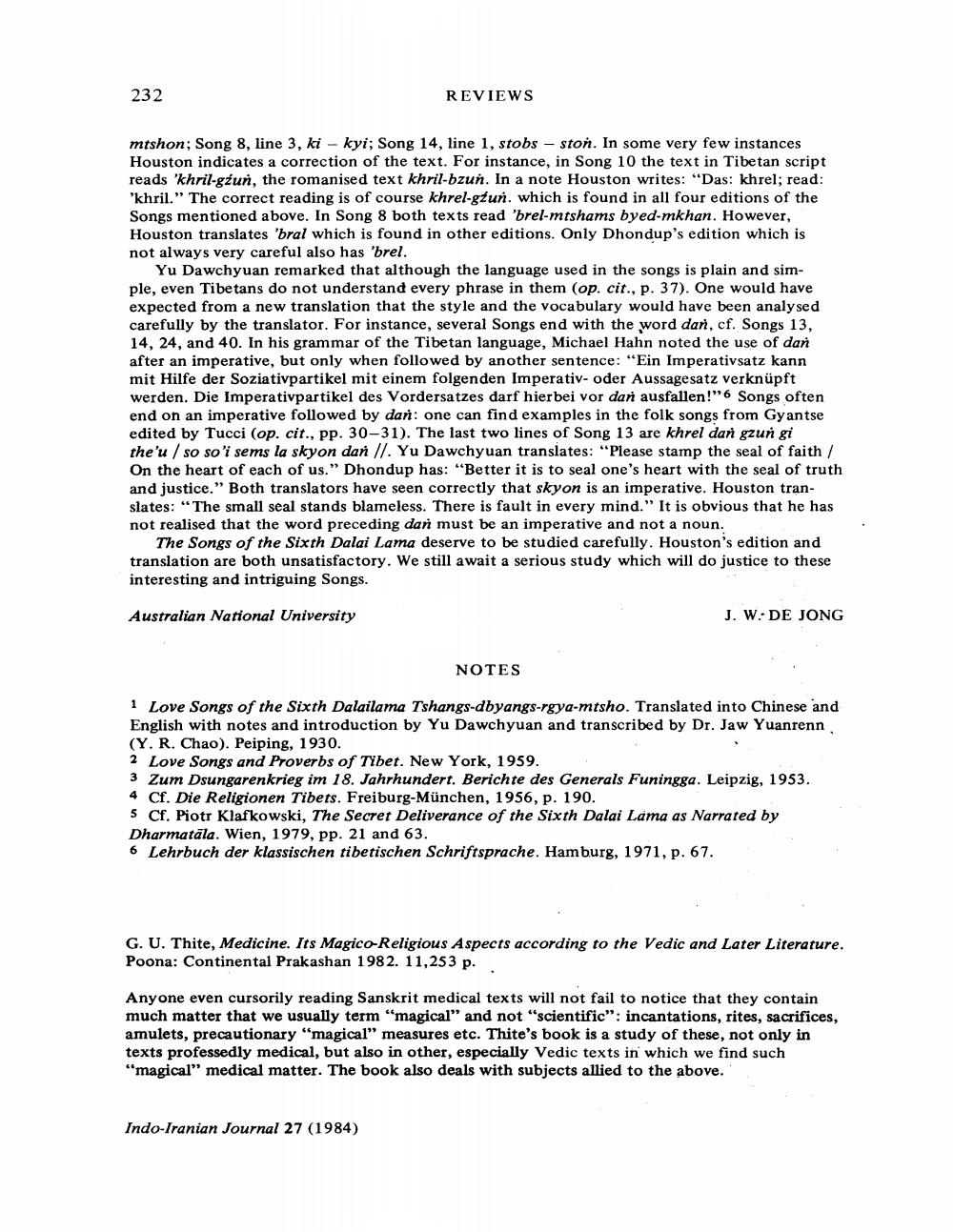________________ 232 REVIEWS mtshon; Song 8, line 3, ki - kyi; Song 14, line 1, stobs - ston. In some very few instances Houston indicates a correction of the text. For instance, in Song 10 the text in Tibetan script reads 'khril-gzun, the romanised text khril-bzun. In a note Houston writes: "Das: khrel; read: 'khril." The correct reading is of course khrel-gzun. which is found in all four editions of the Songs mentioned above. In Song 8 both texts read 'brel-mtshams byed-mkhan. However, Houston translates 'bral which is found in other editions. Only Dhondup's edition which is not always very careful also has 'brel. Yu Dawchyuan remarked that although the language used in the songs is plain and simple, even Tibetans do not understand every phrase in them (op. cit., p. 37). One would have expected from a new translation that the style and the vocabulary would have been analysed carefully by the translator. For instance, several Songs end with the word dar, cf. Songs 13, 14, 24, and 40. In his grammar of the Tibetan language, Michael Hahn noted the use of dan after an imperative, but only when followed by another sentence: "Ein Imperativsatz kann mit Hilfe der Soziativpartikel mit einem folgenden Imperativ- oder Aussagesatz verknupft werden. Die Imperativpartikel des Vordersatzes darf hierbei vor dan ausfallen!" 6 Songs often end on an imperative followed by dan: one can find examples in the folk songs from Gyantse edited by Tucci (op. cit., pp. 30-31). The last two lines of Song 13 are khrel dan gzun gi the'u / so so'i sems la skyon dan //. Yu Dawchyuan translates: "Please stamp the seal of faith / On the heart of each of us." Dhondup has: "Better it is to seal one's heart with the seal of truth and justice." Both translators have seen correctly that skyon is an imperative. Houston translates: "The small seal stands blameless. There is fault in every mind." It is obvious that he has not realised that the word preceding dan must be an imperative and not a noun. The Songs of the Sixth Dalai Lama deserve to be studied carefully. Houston's edition and translation are both unsatisfactory. We still await a serious study which will do justice to these interesting and intriguing Songs. Australian National University J. W:DE JONG NOTES 1 Love Songs of the Sixth Dalailama Tshangs-dbyangs-rgya-mtsho. Translated into Chinese and English with notes and introduction by Yu Dawchyuan and transcribed by Dr. Jaw Yuanrenn (Y. R. Chao). Peiping, 1930. 2 Love Songs and Proverbs of Tibet. New York, 1959. . 3 Zum Dsungarenkrieg im 18. Jahrhundert. Berichte des Generals Funingga. Leipzig, 1953. 4 Cf. Die Religionen Tibets. Freiburg-Munchen, 1956, p. 190. 5 Cf. Piotr Klafkowski, The Secret Deliverance of the Sixth Dalai Lama as Narrated by Dharmatala. Wien, 1979, pp. 21 and 63. 6 Lehrbuch der klassischen tibetischen Schriftsprache. Hamburg, 1971, p. 67. G. U. Thite, Medicine. Its Magico-Religious Aspects according to the Vedic and Later Literature. Poona: Continental Prakashan 1982. 11,253 p. Anyone even cursorily reading Sanskrit medical texts will not fail to notice that they contain much matter that we usually term "magical" and not "scientific": incantations, rites, sacrifices, amulets, precautionary "magical" measures etc. Thite's book is a study of these, not only in texts professedly medical, but also in other, especially Vedic texts in which we find such "magical" medical matter. The book also deals with subjects allied to the above. Indo-Iranian Journal 27 (1984)




